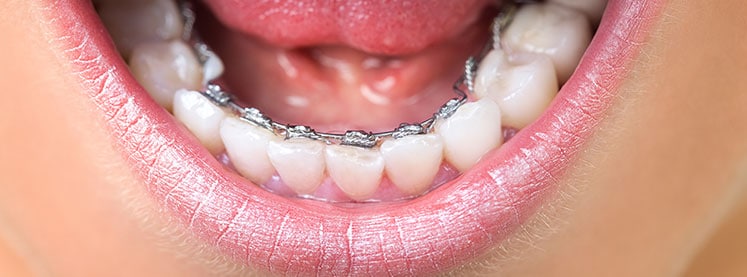When it comes to braces, most patients are interested in minimising the impact of braces has on their smile. Determining the type of braces that’s right for you depends on the dental issue you’re trying to correct and your lifestyle. In this post, we’ll look at your three main dental braces options: ceramic braces, lingual braces and Invisalign aligners.
Ceramic braces

Ceramic braces are a popular alternative to metal braces because they blend well with the colour of the teeth, making them significantly less visible than metal braces and because they are less irritating to the gums. Also, ceramic braces are much less likely to break than metal, which means fewer to no extra trips to the dentist are required. Finally, don’t believe the urban myth that ceramic braces stain easily; ceramic brackets have improved since they first came on the market in the 1980s, and unlike in the early days, the brackets are now stain resistant.
One downside of ceramic braces is that they are not suitable for complex cases. Also, while ceramic braces are cheaper than lingual braces or Invisalign, they do cost more than metal. Because the brackets do work with rubber bands, the bands can stain between adjustments.
Lingual braces

Lingual braces are placed on the back side of teeth, thus remaining invisible. Alternative terms for lingual braces include hidden braces, inside braces, invisible braces and concealed braces. Whereas previously lingual braces could sometimes affect speech due to how they contoured to the teeth, today lingual braces do not carry this side effect and are comfortable to wear. Moreover, unlike ceramic or metal braces, lingual braces allow patients to play wind and brass musical instruments without discomfort, to engage in contact sports and to avoid damaging the surface of their front teeth. The most common brand of lingual braces is Incognito braces, which are 100% customizable. The braces produce quality results within a short period of time and do not require frequent wire adjustments.
Lingual braces do carry a few negatives, such as this type of brace is difficult for patients to clean. Lingual braces are more expensive than either ceramic or metal braces and are not suitable for severe cases. Patients can also find the braces a bit uncomfortable at the beginning, and adjustments do take longer than with other brace types.
Invisalign aligners

Invisalign works well for concerns such as overcrowding, crossbite, overbite and abnormal spacing. With Invisalign, a 3D image will be compiled from x-rays, photos and impressions taken of your teeth, which will then be used to create your customised aligners. The aligners are made from BPA-free plastic, and patients wear the aligners between 20 and 22 hours a day; the aligners are typically only removed when patients eat or perform dental care such as brushing and flossing. The aligners consequently provide more freedom in eating and drinking that other options; for example, patients with braces might shy away from eating foods that would get stuck in their braces or drink foods that would stain the elastics.
New aligners are required approximately every two weeks, as the teeth gradually shift position. This timing means that patients can go through anywhere from 18 to 30 sets of aligners during treatment. Treatment for most patients takes a year to achieve the desired results.
As with other invisible methods, Invisalign is not suitable for serious, complex dental problems and is also not suitable for children. Invisalign is the most expensive option currently and is costly to replace in the event the aligners are lost. Finally, treatment with Invisalign can take longer to achieve the desired results than other methods.





